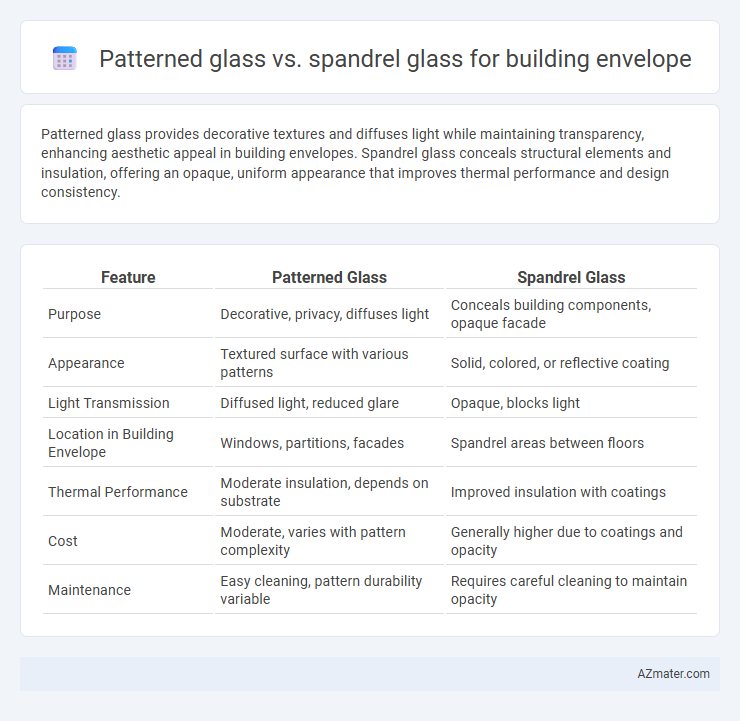Patterned glass provides decorative textures and diffuses light while maintaining transparency, enhancing aesthetic appeal in building envelopes. Spandrel glass conceals structural elements and insulation, offering an opaque, uniform appearance that improves thermal performance and design consistency.
Table of Comparison
| Feature | Patterned Glass | Spandrel Glass |
|---|---|---|
| Purpose | Decorative, privacy, diffuses light | Conceals building components, opaque facade |
| Appearance | Textured surface with various patterns | Solid, colored, or reflective coating |
| Light Transmission | Diffused light, reduced glare | Opaque, blocks light |
| Location in Building Envelope | Windows, partitions, facades | Spandrel areas between floors |
| Thermal Performance | Moderate insulation, depends on substrate | Improved insulation with coatings |
| Cost | Moderate, varies with pattern complexity | Generally higher due to coatings and opacity |
| Maintenance | Easy cleaning, pattern durability variable | Requires careful cleaning to maintain opacity |
Introduction to Building Envelope Glass Types
Patterned glass offers decorative textures that diffuse light and enhance privacy while maintaining natural illumination in building envelopes. Spandrel glass conceals structural elements and floor slabs, providing a uniform exterior aesthetic without transparency. Both types serve distinct functional and design roles, optimizing thermal performance and visual appearance in modern facade systems.
What is Patterned Glass?
Patterned glass refers to textured or embossed glass designed with various surface patterns to enhance privacy, aesthetics, and light diffusion in building envelopes. Unlike spandrel glass, which is opaque and used to conceal structural elements or insulation, patterned glass maintains translucency while offering decorative and functional benefits. Its application improves natural light transmission and reduces glare without compromising the visual appeal of the facade.
What is Spandrel Glass?
Spandrel glass is an opaque or translucent glass used in building envelopes to conceal structural elements, insulation, and mechanical components between floors while maintaining a uniform exterior appearance. Unlike patterned glass, which features decorative textures or designs primarily for aesthetic purposes and light diffusion, spandrel glass is engineered for functional concealment and thermal performance. It often matches the color and reflectivity of vision glass to create a seamless facade in curtain wall systems.
Key Differences Between Patterned and Spandrel Glass
Patterned glass features textured surfaces designed to enhance privacy and reduce glare, while spandrel glass is opaque and used to conceal structural elements or mechanical systems in the building envelope. Patterned glass allows light transmission with decorative effects, whereas spandrel glass blocks vision completely to maintain a uniform exterior appearance. The key difference lies in functionality: patterned glass combines aesthetics and light diffusion, whereas spandrel glass provides concealment and thermal insulation within the facade.
Aesthetic Considerations in Façade Design
Patterned glass enhances facade aesthetics by offering varied textures and visual depth, creating dynamic light diffusion and privacy while maintaining transparency. Spandrel glass provides a uniform, opaque surface that conceals structural elements and mechanical systems, contributing to a sleek, modern exterior appearance. Combining both materials allows architects to balance decorative appeal with functional concealment, optimizing the building envelope's visual coherence.
Light Transmission and Privacy Factors
Patterned glass offers varied light transmission levels due to its textured surface, which diffuses light and enhances privacy by obscuring visibility without completely blocking daylight. Spandrel glass, typically opaque and coated, provides minimal light transmission but excels in concealing structural elements and mechanical components within the building envelope. The choice between patterned and spandrel glass depends on balancing natural light needs with privacy requirements and aesthetic goals in architectural design.
Thermal and Energy Performance Comparison
Patterned glass improves building envelope aesthetics while offering moderate solar heat gain control, but it generally lacks the thermal insulation properties of spandrel glass, which incorporates opaque coatings to enhance energy efficiency by reducing heat transfer. Spandrel glass, often used to conceal structural elements, provides superior thermal performance with higher solar reflectance and lower emissivity, leading to reduced HVAC loads and improved overall energy savings. Selecting spandrel glass over patterned glass can significantly optimize building thermal comfort and energy consumption, particularly in climates with substantial solar exposure.
Durability and Maintenance Requirements
Patterned glass offers enhanced surface texture that improves scratch resistance and conceals dirt, reducing frequent cleaning needs, while spandrel glass, typically coated or painted for aesthetic uniformity, requires specialized maintenance to prevent coating degradation over time. Durability in patterned glass is driven by its tempered or laminated construction, making it resistant to impact and weathering, whereas spandrel glass's durability largely depends on the quality of its coatings and sealants to shield against UV exposure and moisture intrusion. Both materials demand proper installation to maximize lifespan, but patterned glass generally provides lower long-term upkeep costs due to its resilient surface features.
Cost Implications and Installation Factors
Patterned glass generally incurs higher costs due to its decorative surface treatment and customization options, while spandrel glass is more cost-effective, serving primarily as an opaque facade element that hides structural components and insulation. Installation of patterned glass requires careful alignment and handling to preserve aesthetic quality, often extending labor time compared to spandrel glass, which has simpler mounting requirements and faster installation. Both materials impact overall building envelope expenses, but spandrel glass optimizes budget efficiency in large-scale projects by reducing material complexity and installation duration.
Choosing the Right Glass for Your Building Envelope
Patterned glass provides aesthetic appeal and privacy by diffusing light and obscuring views, making it ideal for decorative facades and interior partitions. Spandrel glass, typically opaque and used to conceal building mechanicals and insulation, enhances thermal performance while maintaining a uniform exterior appearance. Selecting the right glass involves evaluating factors such as visual requirements, thermal insulation, structural integrity, and energy efficiency to optimize the building envelope's functionality and design.

Infographic: Patterned glass vs Spandrel glass for Building envelope
 azmater.com
azmater.com